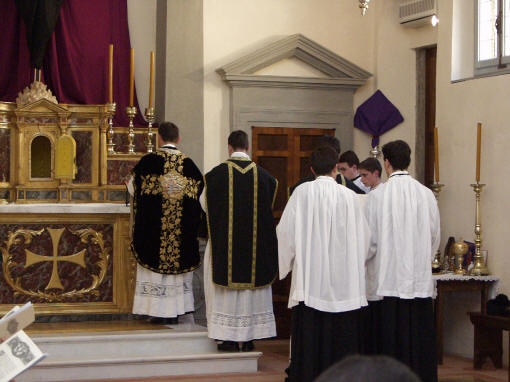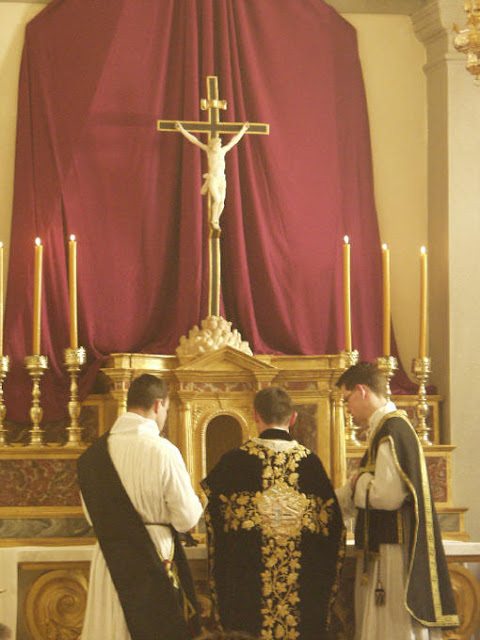First, let me say that contrary to many contemporary opinions the old Holy Saturday liturgy was not at the wrong time. It was at an unusal time, morning, rather than after the canonical hour of None, around 3:00 pm or 4:00 pm, but it was never a night time liturgy. Also, it is not Easter's Mass done the day before, nor is it a midnight Mass, as at Christmas. It is a Mass and liturgy meant to help us anticipate the Resurrection. Let us see what the Church has given us.
A server ignites coals and the priest imposes and blesses incense. He sparges the Holy Fire with blessed water and then incenses it. He also blesses five grains of incense which he be inserted into the Pascal Candle, representing the light of Christ throughout Easter season, inside the church.
The deacon then changes his penitential folded chasuble for a white dalmatic and maniple. He takes a large, triple-branched candle and, lighting a new wick from the Holy Fire, enters the church exclaiming Lumen Christi—"The Light of Christ." This happens twice more until we are in the church proper.
A deacon with the triple-candle preparing to enter the church.
The deacon then petitions the priest for a blessing, approaches the Paschal Candle, which is off to the Gospel side of the altar, and sings the Exultet, a long blessing. The Exultet is rich with imagery of light in the night and the deliverance from Egypt. This day is the deliverance from our spiritual Egypt: Sin and Death. Part way through, the deacon inserts the five grains of incense, calling them an "evening sacrifice," and lights the Paschal Candle. The video to the left is a singing of the Exultet at St. Peter's Basilica two years ago. I find the continued use of the prayer in the newer rites odd, given that none of the actions mentioned in the text are performed, nor is the intention any longer to bless! The prayer concludes with a petition for the Pope and the, no longer extant, Holy Roman Emperor. The lights of the church go on at the words Vere beata nox—"Oh, truly blessed night!" In the middle ages, when this ceremony took place in day light, the windows of the church would be covered in dark cloth, which would be removed at those words, washing the church in God's light after a spiritual slumber.
The deacon returns to his penitential folded-chasuble and, along with the priest and subdeacon, read twelve prophecies, which are chanted by lectors in the middle of the choir. The prophecies together form the story of salvation, both in anticipation and in prediction of Christ:
- Genesis 1:1-31, 2:1-2: The creation of the world by God, the ruler of all things. He sees that it is good.
- Genesis chapters 5-8: The Great Flood and God's commissioning of Noah to build an ark. The ark is a foreshadowing of the Church, which God gives us to protect us from the Flood of Sin.
- Genesis 22:1-9: Abram is about to offer his son, Isaac, but an angel intervenes. For his love of God, the Lord makes a covenant with him and renames the man Abraham.
- Exodus 14:24-15:1: God lets the Israelites pass through Egypt unto freedom through the Red Sea, which drowns the pursuing forces of the Pharoah. Baptism will be our watery means of passing unto freedom.
- Isaiah 54:17, 55:1-11: God has heard the cry of His people and will honor the promises to David.
- Baruch 3:9-38: God has absolute knowledge and dominion over His creation.
- Ezekiel 37:1-14: The bones of the fallen will rise again under the spirit of the Lord.
- Isaiah 4:1-6: The Lord will wash away the "filth of Jerusalem" and build a covenant.
- Exodus 12:1-11: God prescribes the Passover sacrifice of a lamb to the Jews, which will deliver them from God's plague over the first-borns of Egypt. They will be free. Christ is the perfect, spotless Lamb, the perfect sacrifice. He will intercede for us before the Father.
- Jonah 3:1-10: The prophet Jonah convinces the city of Nineveh to repent of their sins and do penance, averting their impending destruction. Penance is necessary to pay the debt of sin, not just to be forgiven.
- Deuteronomy 31:22-30: Moses provides for his death and the continuation of the Israelites into the promised land. This succession of leaders will continue until Christ.
- Daniel 3:1-24: King Nabuchodonosor attempts to kill three Jewish children for not worshiping his idols. They are thrown into a fire, but angels guard them.
In between these readings are sung various prayers and sung psalms. A procession forms and heads to the baptismal font. The priest blesses the empty font and the water in it by plunging the Paschal Candle three times. He sprinkles water towards the four points of the compass and then the faithful with Holy Water from the font, and then infuses Holy Oils into it. He proceeds to baptize and confirm any converts present in the normal manner. The procession then returns to the altar as the choir sings the Litany of Saints, doubling the invocations and answers (ex: choir: Pater de caelis, Deus, Miserere nobis people: Pater de caelis, Deus, Miserere nobis). If there is no font, everything until the Litany is excluded.
Everyone kneels for the duration of the Litany, which takes the place of the Introit of the Mass. The intention of the Litany is mainly to pray for converts, but also for the Church as a whole, as She enters the Paschal mystery. The priest, deacon, and subdeacon remove their outer vestments and prostrate themselves.
Towards the end of the Litany the priest and his ministers rise and head to the sacristy to vest in white vestments for Mass. Servers prepare the altar with the missal and put on the best, most festive frontal.
The priest sings Alleluia for the first time in two months. Absorbed in joy, he sings it three times, each higher and each repeated by the choir. The Gospel, taken from St. Matthew's account of the myrrh-bearing women finding the empty tomb, is accented by the fact that candles are not carried in the procession, emphasizing that the Resurrection has not yet happened for us, but that we are anticipating it. All of this subtlety is indicative of the restraint of the old Roman rite.
The celebrant reads the Gospel before the deacon sings it.
As this is a vigil, the Creed is not sung. There is no verse or chant prescribed for the offertory, so the organ is played or Latin hymns are sung.
The preface is of Easter. During the Canon of the Mass, the Communicantes prayer is unique: "Communicating, and keeping this most holy night of the Resurrection of our Lord Jesus Christ according to the flesh; and also reverencing the memory...." The Pax is not given and the Agnus Dei is omitted. This may be for two reasons: (1) the Lamb is not yet risen and with us or (2) this liturgy is so old that it pre-dates the eighth century introduction of the Agnus Dei.
After communion and the cleansing of the vessels, a short Holy Saturday Vespers is sung rather than a communion chant. It is psalm 116, surrounded by a triple Alleluia. The priest begins the antiphon on the Mangificat: Vespere autem sabati.... During the Magnificat everyone is incensed as usual. The priest sings the post-communion prayer, which I have given below:
Pour forth, O Lord, we beseech thee, the Spirit of thy love into our hearts, and by thy mercy make all them to be of one mind to whom Thou hast given to eat of thy mystic Passover. Through our Lord, Jesus Christ, your Son, Who liveth and reigneth with Thee in the unity of the Holy Ghost, God for ever and ever. Amen.
Queen of Heaven, rejoice! Alleluia!These rites would end about four hours after they started. The main point of celebrating this liturgy early was so that Paschal Mattins and Lauds could start at a reasonable time. The twentieth century de-emphasis of the Divine Office saddens me. Paschal Mattins and Lauds are the most important liturgical event of the entire week, more so than any Mass or office. In these offices we formally begin the celebration of the Resurrection. In Eastern Churches the people wander the church looking for Christ, but not finding Him! He is risen! They then sing Mattins and Lauds at midnight, followed by Divine Liturgy. The Divine Liturgy is of Easter Sunday, it is not a vigil nor is it a midnight Mass, as we have on Christmas. The reformers lost this critical difference and canned the most important office of the year in the process.
For He Who you did merit to bear, Alleluia!
Has risen as He said, Alleluia!
Pray for us to God, Alleluia!
In the West there would be a Resurrection ceremony, which would find the sepulcher created on Good Friday empty, the crucifix would be adored again as on Good Friday, and Mattins and Lauds would be sung. Mattins has one nocturn, with lesson from a sermon of Pope St. Gregory the Great, in which the saintly pontiff says we, the Church, must come to Christ's tomb bearing gifts like the women if we are to be surprised and rejoice. The Te Deum is sung de tempore for the first time in two months. At Lauds, the first antiphon declares that an angel descended from heaven to roll back the stone. The antiphons for this Lauds are among the most beautiful of the year. There is no hymn at Mattins or Lauds. The dismissal has a double Alleluia, as at Mass. The office ends with the Regina Coeli again. Easter has begun at this point.



























